DEVELOPED ROCKET-POWERED INDIVIDUAL LIFT DEVICES
Nearly 40 years have passed since the first man flew with a rocket pack strapped on his back, and not once has its design, originally envisioned by inventor Wendell F. Moore; ever been improved upon by successive designs.
All subsequent versions of the rocketbelt have had the same disadvantages; low flight duration. This is mainly due to the limit of how much weight a man can carry on his back and to the fact that later versions were copies of Moore’s who didn’t design his pack for optimized flight endurance.
|
Device |
Bell Aerosystems Rocketbelt |
Tyler Systems Rocketpack |
American Flying Belt |
Thunderbolt Aerosystems ThunderPack
|
|
SRLD |
|
RB2000 |
TP-R1G2 |
TP-R2G2 |
Takeoff Weight, lbs |
277 |
285 |
287 |
293 |
350 |
Empty Weight, lbs |
70 |
78 |
75 |
58 |
72 |
Pilot + Payload
Pilot
Payload |
160
160
0¹ |
160
160
0¹ |
160
160
0¹ |
160
160
0¹ |
180
160
20 |
Total Fuel, lbs |
47 |
47 |
52 |
75 |
98 |
Range, feet |
866 |
800 |
890 |
2760 |
3650 |
Speed, mph |
60+ |
60+ |
60+ |
75+ |
Endurance, seconds |
21.5² |
20² |
30² |
35² |
75² |
Type of Fuel |
90% |
90%- H²O² |
90%- H²O² |
PERTOL³ |
PERTOL/JP44 |
Propellant Isp, sec |
122 |
120 |
124 |
133 |
181 |
Total Rocket Thrust, lbs |
300 |
300 |
300 |
335 |
380 |
- Not designed to carry any payload
- Excludes 10 seconds reserve
- Specially formulated 90 – 98% H²O²
- Jet Aircraft Propellant (refined kerosene)
In 1996, California engineer Carmelo “Nino” Amarena took on the challenge of building a new generation of rocketpacks that would break the barrier plaguing all previous pack designs and embarked on an investigation of what needed to be done, modified or invented to make longer flight a reality. It was a challenge that required much more than merely copycatting. Amarena was trained and educated at the Buenos Aires University of Engineering, in Argentina where he obtained his masters degree in electro-mechanical engineering and upon immigrating to America in 1979, made his home in California’s Silicon Valley.
There he was able to interact with talents in cybernetics, aerospace and electronics industry, allowing him to acquire a set of skills, which forged his “technical generalist” background.
His broad technical background eventually landed him the development of a peroxide-based reciprocating engine for GeorgiaTech Research Institute’s “Entomopter” a biomimetic robot that flies like a “dragon fly” insect, a joint project between NASA and GeorgiaTech planned to be sent to with a landing Mars probe mission by the end of the first decade of the 21st century.
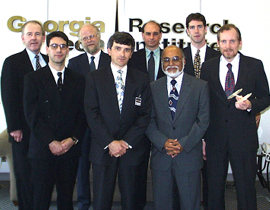
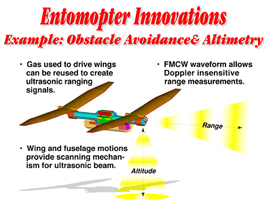
The GeorgiaTech “Entomopter” team (Amarena is second from left, front row) and summary of its innovations (right).
In order to develop this new generation rocketbelt, Amarena formed Thunderbolt Aerosystems, Inc. in 1997 with the financial help of two partners. The company’s mission is to design and manufacture personal flight machines for entertainment, pleasure and rescue purposes. Its first model was dubbed ThunderPack®-R1G2 (Revision-1; Generation-2) and was sold in 2003 to a large corporation in the far east, with intentions to use the R1G2 for rescue purposes.
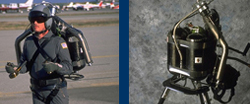 The ThunderPack-R1G1 during the prototype
The ThunderPack-R1G1 during the prototype
phase test (left) and on its pre-flight standThe ThunderPack® was designed with many similarities to Wendell Moore’s rocketbelt of the ‘60s. Much of Moore’s work laid the foundation for the whole idea of fitting a rocket to a man’s body. For this reason, Thunderbolt Aerosystems obtained many of the original technical reports from Bell Aerosystems as well as from ex-Bell and NASA engineers, whom helped in understanding the man-machine kinematics of flying with a rocket pushing 1,200 jet horsepower on a person’s back. The challenge for Amarena, was how to lengthen its flight
endurance.
The amount of time a rocket-powered vehicle can stay aloft is dependent on how much fuel is available to burn, how much the flight vehicle (pilot, ship and fuel) weighs and how much thrust can be generated per pound of fuel. It was obvious from this that the only way to extend flight duration was by increasing the amount of fuel, increasing the amount of thrust per pound of fuel, (being measured in rocketry by a unit called Specific Impulse [Isp]) and decreasing the flight vehicle weight. With the plan formulated, work began in early 1998.
The ThunderPack® project began by establishing four phases:
- The design phase: new and proven ideas of rocketpacking got established.
- The prototype phase: reliability testing and improvements of every component and system identified in the design phase.
- The manufacturing phase: final drawing versions of the parts are produced.
- The testing phase: assembly and first firing of rockets, system checks, redundancy devices activation and preparation for first tether/solo flights.
The rocket propulsion used in the ThunderPack® -R1G2 and its later incarnation, the ThunderPack-R2G2 are very similar to Bell’s rocketbelt. It uses a variation of hydrogen peroxide in high concentration (between 70 and 98% by weight) plus other propellant additives. This versatile chemical discovered by the French chemist Jules Thenard in 1818, has been used all the way from wounds’ bactericide, to rocket propulsion like those in the Mercury capsules RCS system, Redstone fuel turbo-pump power drive, lunar module lander trainer main propulsion, Bell’s X-1, X-1A and X-15 rocket planes and many other aerospace applications.
When peroxide in the proper formulation and concentration contacts certain metals at ambient temperature, it quickly decomposes (about 10 – 100 milliseconds) into superheated steam, oxygen gas and heat (between 1000 to 1750ºF depending on concentration). But what makes this chemical so useful for rocket propulsion is that for every pound of peroxide that totally decomposes, about 61 cubic feet of gas is generated or in another way; for every volume of peroxide that is decomposed, 5,000 equal volumes of gas is generated. If the fuel is fed into the rocket engine at a certain pressure —say 1,000psi— then the gas generated will also be at 1,000psi and having this large volume of gas coming out of the rocket nozzles at high pressure, its what gives the “jet” thrust to the pack. Because the chemical reaction is produced without flames, it is the main reason Moore chose peroxide for his pack, and that’s why Amarena did as well.
In order to improve the already energetic content of hydrogen peroxide, Nino Amarena and his team launched a search for formulas that would increase the “punch”of peroxide without making it unstable or toxic. The search of over 2,500 technical documents, going back as far as 1850 proved to be productive. The team found that, by combining some specific additives, promoters and decomposition enhancers, it was possible to increase the specific impulse (Isp) by almost 10% over traditional hydrogen peroxide. They named the new formula PERTOL®, and applied for a patent for placement on the aerospace market.
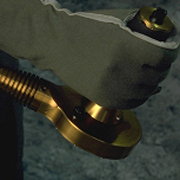 |
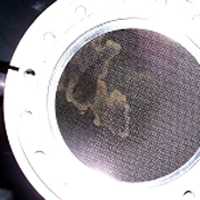 |
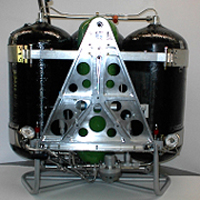 |
ThunderPack’s innovative throttle employs
novel ergonomic
“torsion control” allowing
for finetuning to pilots’ individual preferences |
A typical peroxide reactor
engine as used in the ThunderPack |
ThunderPack TP-R1G2 on a test
bench during reliability tests |
The extra fuel capacity and more energetic fuel needed only to be complemented by a lighter overall system weight in order obtain the perfect ThunderPack flight endurance. The whole pack was built with aerospace quality materials like; Titanium, Inconel®, Hastelloy® and Magnesium as well as composite carbon-fiber, graphite pre-pegs and Kevlar® structures. Through the use of these materials, the ThunderPack® was 35% lighter (empty and without pilot) than Moore’s rocketbelt.
The final touch to lengthening flight time, was fitting fuel tanks with twice the capacity of Moore’s. The savings in weight while the pack is empty (42%) is replaced by the extra weight of additional fuel capacity. Coupled with the more energetic formulation of PERTOL®, the various models of ThunderPacks® are capable of in excess of 45 seconds of flight autonomy at full throttle. Since it burns about two pounds per second of fuel, it continually gets lighter; therefore from take off it consumes two pounds of thrust per second less for every second of flight. This fact and the pilot’s mastering of the throttle, are the main factors affecting flight duration variations.
Not satisfied that all means for extending flight endurance had been applied to the new pack design, Nino Amarena’s team decided to add an innovative dual-fuel or bipropellant mode of operation. The second fuel is a hydrocarbon or organic; like kerosene, jet gasoline, diesel or even paint thinner, which together with the peroxide increases the Isp considerably, lengthening the pack’s flight duration up to 75 to 90 seconds. With the extra thrust provided by the bipropellant mode, it was possible for the first time to have a rocketbelt carry a payload (about 10 lbs) other than its pilot.
All these innovations, improvements and refinements represent the high-technology design criteria the ThunderPack® has undergone, making it the “ultimate” personal flying machine!
Thunderbolt Aerosystems is currently looking for relocating into a larger aviation research facilities where the fourth generation of personal flying devices, like the ThunderPack® will evolve into the ThunderJet®. Also additional facilities are being built to accommodate Thunderbolt Aerosystems’ Camp-Zero® where plain mortals will have a chance to learn to fly the ThunderPack aided by their Tether-Trainer®.
For more information about other scheduled appearances of ThunderBolt Aerosystems’ ThunderMan visit our UPCOMING EVENTS & PRESS CENTER link and check the list of upcoming events. If you are interested in contracting Thunderman to enhance your Public Relations efforts check our link Entertaining Appearances for Hire.

